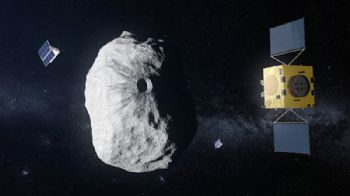
The European Space Agency’s (ESA) proposed Hera mission is already scheduled to visit two asteroids, the Didymos binary pair; the Hera team says it now hopes to perform a fly-by of another asteroid during the mission’s three-year flight.
The opportunity arises because Hera will be flying out to match Didymos’s 770-day orbit, which varies from less than 10 million km from Earth to out beyond Mars, at more than double Earth’s distance from the Sun. In the process, Hera will pass both multiple near-Earth asteroids and the inner edge of the main asteroid belt.
Initial studies at ESA’s European Space Operations Centre have turned up dozens of ‘candidate’ asteroids across different mission scenarios.
ESA’s Hera project scientist (
www.esa.int), Michael Küppers, said: “Ideally, we would like a fly-by of another binary asteroid to compare it with Didymos.
“We would choose something of a different taxonomic type from S-type asteroids like Didymos. We would also prefer a larger object, as its greater size would allow us to resolve it meaningfully from further away.”
Highlighted is the 2121 Sevastopol binary pair in the inner belt, which has an 8.6km-diameter main body plus a 3.5km-diameter moon and is a member of the “poorly understood” Flora family of main-belt stony asteroids, produced by
a collision event a ‘relatively recent’ 100 million years ago.
ESA’s Rosetta comet-chaser performed fly-by of two asteroids as it passed through the main belt (during its decade-long flight to comet 67P/Churyumov–Gerasimenko): the 5km-diameter diamond-shaped 2867 Steins and the 120km-diameter 21 Lutetia.